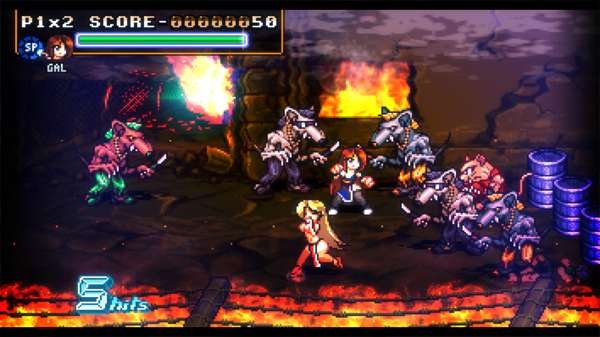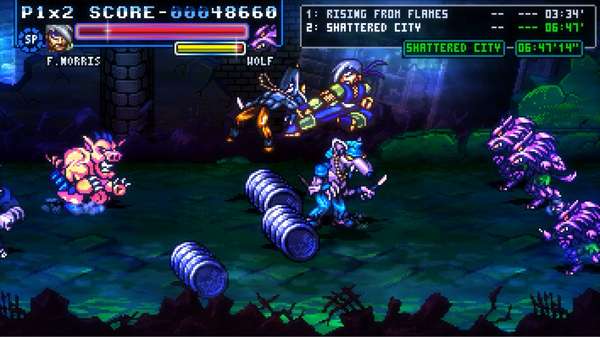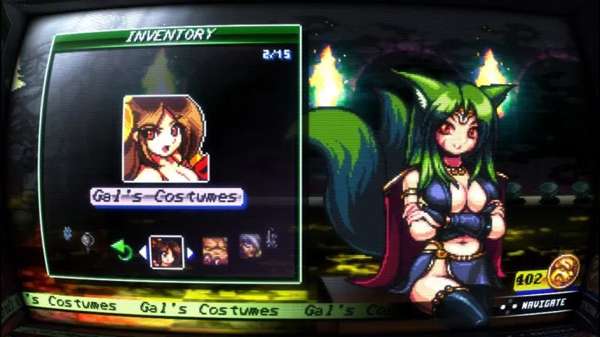
Fight’N Rage Switch Review
In every generation of videogames, there have always been trending genres that practically every developer and publisher sought out to over-saturate in the hopes of cashing in on their fleeting popularity. These days, it’s the Battle Royale market (complete with loot boxes and other increasingly skeevy forms of microtransactions); prior to that, First Person Shooters dominated the console space. The late 90’s had RPGs thanks to breakout debut of Final Fantasy VII, and a few years before that saw the success of Street Fighter II and Mortal Kombat lead into a literal swelling of Fighting Games that dominated arcades and home consoles everywhere.
But if we go back even further, the early-to-mid 90’s was host to another brief-yet-defining genre of videogame: Beat ‘Em Ups. Just like Fighting Games, Beat ‘Em Ups began life in the Arcade with coin-collecting hits like Final Fight and console classics like Streets of Rage, with many proceeding titles based around various licensed properties including The Simpsons, Teenage Mutant Ninja Turtles, X-Men and others. Though the trend did not last quite as long as some of the others mentioned above, the Beat ‘Em Up style of gameplay became a recognizable standard that is still utilized to this very day…thanks largely to Indie devs with a love of all things retro.

Sebagamesdev is one such studio with a nostalgic fondness for four directional face punching, and the one-man dev behind Seba has channeled that love into a burning fist of fury in the form of Fight’N Rage. Originally released for PC in 2017, the game has now moved onto the Nintendo Switch (in addition to PS4 and Xbox One) like so many other Indie titles, further cementing the console/handheld hybrid as a much better curated platform for independent games, minus the occasional shovelware trash here and there.
True to the genre it draws inspiration from, Fight N’ Rage has a simple story premise with very little backdrop: a post-apocalyptic world featuring humans being overtaken by powerful anthropomorphic animals known as “Mutants”, where only a few surviving remnants of humanity attempt to fight back and hold off the worldwide slaughter. The three main protagonists include a martial arts woman known as Gal (who has quite the, let’s say, “Mid 90’s” character design and…chest physics), the silent skilled ninja F. Norris, and the requisite “slow-moving guy with wrestling throws” Mutant-turned-sympathizer bull Ricardo. Together, the three fighters make their way across several Mutant-occupied areas in order to take down their boss before his invasion wipes out the entirety of mankind.
As mentioned before, the particulars of the premise behind Fight N’ Rage’s setting are kept to a minimum, but the game still has a surprisingly more in-depth story than one would normally expect from the genre; though the main goal of Arcade Mode is to run through a gauntlet of enemies, bosses, mini-bosses and barrels in one playthrough, there are actually several branching points littered throughout that can lead to some dramatically different outcomes. In what may be particularly familiar to anyone who’s played NieR Automata, Fight N’ Rage features several letter-graded endings depending on a variety of factors and decisions made during each playthrough, such as team composition or which path to take during a fork in the stage. And despite the playful art style consisting of gorgeous pixelated sprites and the variety of fun enemy designs, the story can also lead to some rather brutal scenes including mass slaughter, slavery, and even cannibalism. These sudden tone shifts can occasionally clash between moments of surfboarding, breaking into a nightclub and punching enemies so hard that they explode into skeletons, but can also serve as motivation to seek out the different ending outcomes where such tragedies can be prevented.

As for the scenarios regarding a specific team composition, Fight’N Rage has a handy feature in place for anyone unable to wrangle up some real life friends for the local-only co-op; the game allows the ability to set CPU-controlled characters to assist the main player in Arcade runs, and while the game does cheekily mention that these AI assistants aren’t as smart as actual flesh-and-blood players, they do generally get the job done in taking out the opposition with each character’s combo-heavy move set. Furthermore, CPU characters can revive themselves after losing all their lives, which can come in handy for players striving for a perfect No Continue run.
Sure enough, the action in Fight’N Rage is set to the precise level befitting a nostalgic retread of the Beat ‘Em Up genre: Frantic. A single player run can already result in an increasingly cluttered screen of enemies attacking from every direction. Adding up to three players in the mix is pure chaos, but also sets up the opportunity for more enemy-juggling combos, which is both satisfying and necessary; each character has their standard bread-and-butter attack strings and throws, but to truly survive the escalating onslaught of opposition, players must learn to utilize the more advanced tools in their arsenal. This includes the ability to parry attacks with precise button timing, keeping an enemy in the air for as long as possible with precision attacks, and especially making sure to manage their special attack meter.

True to its source material, Fight’N Rage allows players to unleash a crowd-clearing special attack at the cost of their SP meter, which refills over time. Busting out special attacks while the meter is empty will subtract from the player’s life bar instead, a common risk/reward system found in the majority of Beat ‘Em Ups but with a more strategic emphasis here: special attacks can be used to interrupt enemy combos, break out of devastating throws, and can also keep a lengthy attack combo going for maximum damage. Go overboard with the special attacks and run the risk of death with the next hit, or risk everything to try and finish off the last waves of enemies before that happens. All these possible outcomes lead to a slightly more strategic element rarely seen in this button-mashing genre, but it also leads to a lot more exciting matchups. Just consider investing in a controller with a more functional D-pad than the Switch Pro or Joycons; a SNES-style replica like the ones offered by 8BitDo or the online-exclusive brand by Nintendo themselves will make it far easier to execute those quick double-tap motions for sidestepping and other crucial maneuvers.
From a production standpoint, Fight’N Rage perfectly captures the sights and sounds of yesteryear, or rather a modern facsimile that is far more advanced than the classic Arcade titles it pays homage to. The visuals are a gritty blend of cartoony sprites and pixelated particle effects, looking closer to a Battletoads remake than the actual Battletoads remake, while the music is a persistent jam of heavy butt rock. Everything is fast and fluid, save for the few moments where it isn’t: on the Switch port at least, there have been a few instances of sudden slowdown, and not because of the screen filling up with enemies. These moments seem to happen completely randomly, and not always in the same instance. It can also be quite difficult to spot each player’s character during three-man runs, in which the maximum amount of insanity fills the screen to block out characters like a crowded mosh pit. Those minor gripes aside, the game looks great and properly captures that classic Arcade aesthetic, right down to various CRT and scanline options. And as mentioned before, there are a plethora of extra features that can be obtained with the in-game currency (collected as a final score tally for each run of Arcade Mode, with bigger payouts at higher difficulties). These coins can be used to earn extra costumes for the characters, playable enemies for the 1-on-1 Battle Mode, and add-ons that serve as game tweaks including Turbo Mode, Harder Difficulty, Time Attack, Score Attack and so on. Remember when it didn’t cost extra money to unlock these features through DLC? Winning things by playing the game is another retro feature that desperately needs a comeback.

In the end, Fight’N Rage can’t escape its short run-time which is prominent with every Beat ‘Em Up game (they were originally created to serve as short Arcade experiences, after all), but the branching story paths, combo-heavy characters and numerous unlockable extras more than make up a full package filled with incentives to keep playing. As a modern throwback to Arcade classics, Fight ‘N Rage is one of the very best in the business right now.
